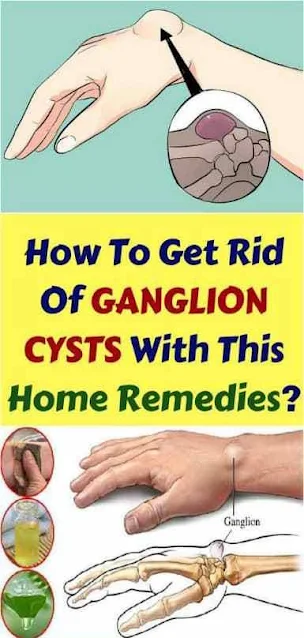Physicians are not entirely certain of the cause of ganglion cysts. They manifest as tiny rips in the joint capsule or tendon membrane that let the viscous synovial fluid that envelops the tendon or joint seep out and gather in a sac.
These fluid-filled enlargements typically develop on the wrists and backs of the hands, but they can also form on the knees, ankles, and feet (home remedies for ganglion cysts in the foot work similarly to those for the wrist). Since the cyst is benign (not cancerous), it will frequently go away on its own without the need for medical attention.
Standard medical treatment for these cysts usually involves surgical removal or fluid extraction with needles. If you want to know how to get rid of ganglion cysts, then fear not. There is a ganglion cyst home treatment for you that can reduce the swelling and alleviate pain without the need for surgery.
Ganglion Cyst Home Treatment
Black or green tea (Camellia sinensis)
Black and green tea has been proven to contain antioxidant properties, anti-inflammatory activities, and can even inhibit tumor growth. While tea cannot remove a ganglion cyst, it can help alleviate the pain and swelling, and help prevent the condition from worsening.
To benefit from its anti-inflammatory effects, simply dip a green or black tea bag in warm water for about five minutes. Take it out and squeeze away any excess water.
Place the wet and warm tea bag on the swelling for approximately 10 minutes. You can repeat this process several times a day to cope with any pain or discomfort caused by the cyst.
Ginger
Likewise, ginger has long been used to address a large range of ailments, such as gastrointestinal disorders (stomach aches, nausea, vomiting, etc.), arthritis and motion sickness.
The antioxidant, anti-inflammatory, and anticarcinogenic properties of its active ingredients (e.g. gingerols and shogaols) can help alleviate the pain, inflammation, and discomfort caused by ganglion cysts.
You can introduce more ginger into your diet through various ways. You can consume it in liquid form (e.g. by drinking 2-3 cups of ginger tea each day), in supplement form, or add more ginger to your cooking.
Turmeric
Turmeric works in a similar fashion and is another great home treatment for ganglion cysts. It is a potent herb with anti-inflammatory, antioxidant, antimicrobial, hepatoprotective, immunostimulant, antiseptic, and antimutagenic qualities.
Scientists have identified curcumin, a diferuloylmethane, as the active agent within turmeric.
It has been proven to “regulate numerous transcription factors, cytokines, protein kinases, adhesion molecules, redox status and enzymes that have been linked to inflammation”.
To help alleviate any pain or discomfort caused by a ganglion cyst, apply a mixture of turmeric powder and warm water to the swelling two to three times each day over a few days. You can also consume it in supplement form, or by adding it to your cooking.
Ginseng
Ginseng has long been used as a traditional medicinal herb, and modern science has recently validated its various health benefits.
Scientific research has studied and analysed its antioxidant, anti-inflammation, anti-fatigue, antidiabetic, antitumor, immunomodulation, anti-obesity, cardioprotective, antimicrobial, neuroprotective and aphrodisiac properties.
In particular, its bioactive with anolides are helpful in suppressing a variety of inflammatory and carcinogenic agents and can be used as a ganglion cyst home treatment.
Ginseng can be consumed via various forms: whole root, root powder (white ginseng), teas, standardized root extracts, steamed root powder (red ginseng), heat processed root powder (sun ginseng), and steamed and dried roots for five days and nine times respectively (black ginseng).
Scientists have faced challenges in precisely quantifying the medicinal properties of ginseng, since ginseng preparations can differ according to the species used, the age and part of the plant used, the method of preservation, the method of extraction and the season of harvest.
Echinacea (purple coneflower)
Native American communities have used the nine known species of Echinacea (also known as the purple coneflower and American coneflower) as a form of traditional medicine.
It has been used as a dietary supplement to fight again the common cold and other infections due to its perceived ability to boost the immune system, and has been applied to wounds and skin problems.
Scientific research has demonstrated that Echinacea consumption increases the production of the complement properdin, which boosts and stimulates the immune system.
To benefit from its immunomodulating effects, you can consume the plant in the form of tea, squeezed juices, extracts, capsules or tablets.
Frankincense oil
Frankincense is a traditional Eastern medicine and a great ganglion cyst home treatment. It contains Boswellia resin, which has various anti-inflammatory, expectorant, antiseptic, and even anxiolytic and anti-neurotic properties.
Scientific research has demonstrated its analgesic, anti-inflammatory, tranquilizing, anti-bacterial effects and anti-proliferative effect on tumors.
To benefit from its therapeutic properties, simply apply two drops of frankincense oil onto your swelling and cover it with a clean bandage.
Change the bandage once each day, until the pain and discomfort subside.

